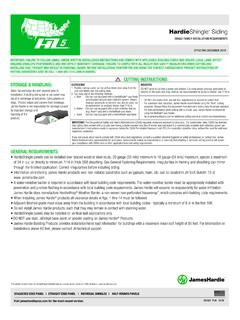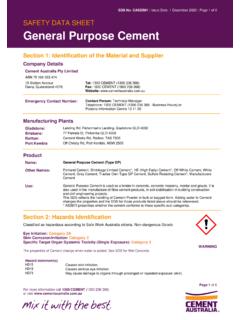Transcription of Handheld Grinders for Tasks Other Than Mortar Removal
1 CONTROL OF silica dust IN construction Handheld Grinders for Tasks Other Than Mortar RemovalThe use of a Handheld grinder to smooth or cut the surfaces of concrete, masonry or Other silica containing materials can generate respirable crystalline silica dust . When inhaled, the small particles of silica can irreversibly damage the lungs. This fact sheet describes dust control that can be used to minimize the amount of airborne dust when using Handheld Grinders for uses Other than Mortar Removal as listed in Table 1 of the respirable crystalline silica Standard for construction , 29 C F R 19 26 .115 3 .Engineering Control Method: Water applied continuously to the grinding wheel OR Vacuum dust Collection SystemTwo methods for controlling dust when operating Handheld Grinders for smoothing or cutting surfaces, and uses Other than Mortar Removal are: (1) use a grinder equipped with an integrated water delivery system (outdoors only); or (2) use a grinder equipped with a commercially available shroud and vacuum dust collection system.
2 The grinder must be operated and maintained in accordance with the manufacturer s instructions to minimize dust MethodsGrinders equipped with an integrated water delivery system can be used to control dust when cutting, grinding, or polishing granite, concrete or Other materials containing crystalline silica outdoors. A water faucet or pressurized container can be used to supply a constant spray of water to the grinding wheel. When used outdoors, water-fed Grinders can control dust on uneven surfaces and near corners and edges more effectively than vacuum dust collection Safety. Where water is used to control dust , electrical safety is a particular concern. Use ground-fault circuit interrupters (GFCIs) and watertight, sealable electrical connectors for electric tools and equipment on construction courtesy of OSHAE xample of a Handheld grinder with integrated water delivery system.
3 Make sure to: Check that hoses are securely connected and are not cracked or broken. Adjust nozzles so that water goes to the grinding surface or cut point. Water flow rates must be sufficient to minimize the release of visible dust . Set a regular schedule for maintenance and cleaning of the tool and up any slurry produced to prevent the slurry from drying and releasing silica dust into the air. Wet slurry can be cleaned up using, for example, shovels or a wet vacuum equipped with a HEPA dust Collection System (VDCS)Employers can also comply with Table 1 in the silica standard by using a VDCS to control dust when using a Handheld grinder. Use a: Commercially available shroud and dust collection system on the grinding wheel appropriate for the grinder and wheel size. Vacuum that provides at least 25 cubic feet per minute (cfm) of airflow per inch of blade to capture dust at the point of grinding.
4 For example, a 5 grinding wheel would require a rating of 125 cfm of air flow or more for effective capture. Vacuum equipped with a cyclonic pre-separator or filter- cleaning mechanism with a filter that has 99 percent or greater collection efficiency for respirable -sized particles. Vacuum exhaust hose capable of providing the airflow recommended by the tool manufacturer. A to 2 diameter vacuum exhaust hose is typically sure to: Keep the vacuum hose clear and free of debris, kinks, and tight bends. Follow the equipment manufacturer s directions on how to reduce dust buildup on the filter. Change vacuum-collection bags as directed by the manufacturer. Do not overfill the bag. Set a regular schedule for maintenance and filter cleaning of the drill and VDCS. Avoid exposure to dust when changing vacuum bags and cleaning or replacing air courtesy of NIOSHD etail of grinder with vacuum dust collection system attachment.
5 Respiratory ProtectionWhen properly used, wet methods can effectively control exposure to silica dust . Therefore, Table 1 does not require the use of respiratory protection when operating Handheld Grinders outdoors using wet using a VDCS, respiratory protection with a minimum Assigned Protection Factor (APF) of 10 is required whenever Handheld Grinders are used indoors or in enclosed areas for more than 4 hours per respirators are required, employers must put in place a written respiratory protection program in accordance with OSHA s Respiratory Protection Standard 29 CFR of Compressed Air: Unless there is a ventilation system that effectively captures the dust cloud, do not use compressed air or blowers to clean surfaces, clothing or filters because it can increase exposure to silica . Instead, clean only with a HEPA filter-equipped vacuum or by wet or in Enclosed AreasUsing a Handheld grinder with a VDCS indoors or in an enclosed area may not be relied on to keep exposure low, so extra ventilation may be needed to reduce visible airborne dust .
6 Extra ventilation can be supplied by using: Exhaust trunks Portable fans Air ducts Other means of mechanical ventilationEnsure air flow is not impeded by the movements of employees during work, or by the opening or closing of doors and windows. Position the ventilation to move contaminated air away from the workers breathing InformationFor more information, visit and see the OSHA Fact Sheet on the crystalline silica Rule for construction , and the Small Entity Compliance Guide for the respirable crystalline silica Standard for can provide compliance assistance through a variety of programs, including technical assistance about effective safety and DSG FS-3628 12/2017 This is one in a series of informational fact sheets highlighting OSHA programs, policies or standards. It does not impose any new compliance requirements. For a comprehensive list of compliance requirements of OSHA standards or regulations, refer to Title 29 of the Code of Federal Regulations.
7 This information will be made available to sensory-impaired individuals upon request. The voice phone is (202) 693-1999; teletypewriter (TTY) number: (877) programs, workplace consultations, and training and education. OSHA s On-Site Consultation Program offers free, confidential occupational safety and health services to small and medium-sized businesses in all states and several territories across the country, with priority given to high-hazard worksites. On-Site consultation services are separate from enforcement and do not result in penalties or citations. To locate the OSHA On-Site Consultation Program nearest you, visit www. osha. RightsWorkers have the right to: Working conditions that do not pose a risk of serious harm. Receive information and training (in a language and vocabulary the worker understands) about workplace hazards, methods to prevent them, and the OSHA standards that apply to their workplace.
8 Review records of work-related injuries and illnesses. File a complaint asking OSHA to inspect their workplace if they believe there is a serious hazard or that their employer is not following OSHA s rules. OSHA will keep all identities confidential. Exercise their rights under the law without retaliation, including reporting an injury or raising health and safety concerns with their employer or OSHA. If a worker has been retaliated against for using their rights, they must file a complaint with OSHA as soon as possible, but no later than 30 additional information, see OSHA s Workers to Contact OSHAU nder the Occupational Safety and Health Act of 1970, employers are responsible for providing safe and healthful workplaces for their employees. OSHA s role is to ensure these conditions for America s working men and women by setting and enforcing standards, and providing training, education and assistance.
9 For more information, visit www. or call OSHA at 1-800-321-OSHA (6742), TTY 1-877-889-5627.













